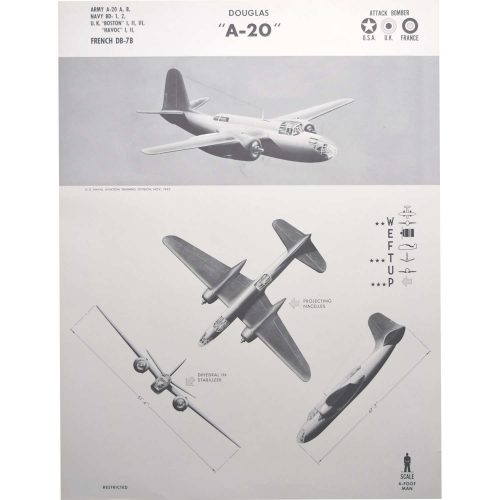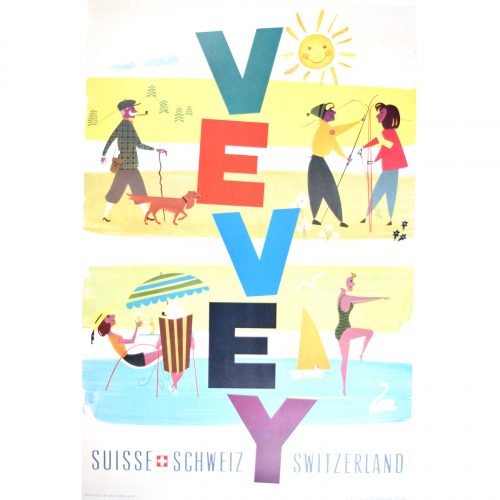-
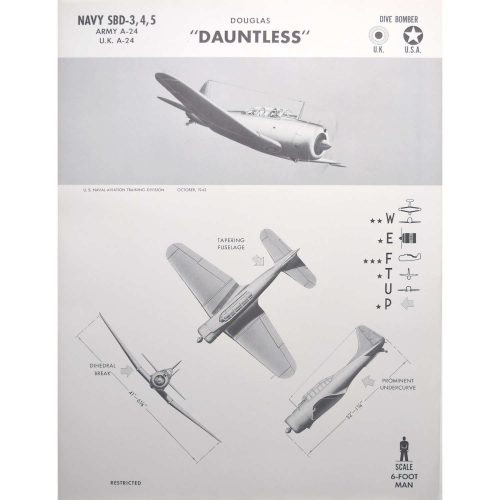
Navy SBD-3, 4, 5, Army A-24 Douglas "Dauntless"
Aeroplane identification poster, published 1942 63 x 47 cm A particularly unusual style of aeroplane identification poster, owing to the very arty images. Most such posters rely on very plain silhouettes, this series - and we have several in this series; view them here - have a much more arty approach to the task with shading and an interesting angle view. The Douglas SBD Dauntless was a World War II American naval scout plane and dive bomber that was manufactured by Douglas Aircraft from 1940 through 1944. The SBD ("Scout Bomber Douglas") was the United States Navy''s main carrier-based scout/dive bomber from mid-1940 through mid-1944. The SBD was also flown by the United States Marine Corps, both from land air bases and aircraft carriers. The SBD is best remembered as the bomber that delivered the fatal blows to the Japanese carriers at the Battle of Midway in June 1942. During Midway, four squadrons of Dauntless dive bombers attacked and sank or fatally damaged all four Japanese fleet carriers present, disabling three of them in the span of just six minutes (Akagi, Kaga, and Sōryū) and, later in the day, Hiryū. During its combat service, the SBD proved to be an excellent naval scout plane and dive bomber. It possessed long range, good handling characteristics, manoeuvrability, potent bomb load, great diving characteristics from the perforated dive brakes, good defensive armament, and ruggedness. Condition: generally very good. If you are interested, please email info@manningfineart.co.uk or call us on 07929 749056. -
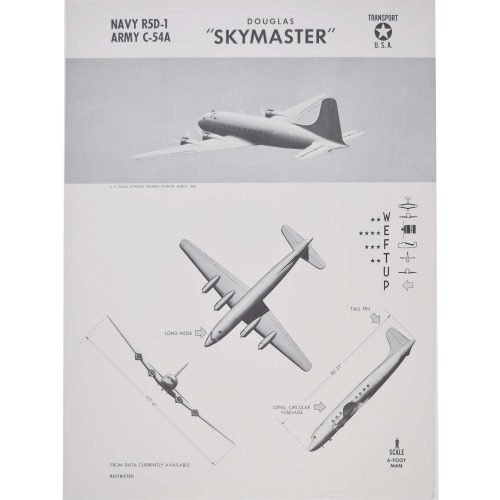
1942 Navy R5D-1 Army C-54A Douglas "Skymaster"
Aeroplane identification poster, published 1942 63 x 47 cm A particularly unusual style of aeroplane identification poster, owing to the very arty images. Most such posters rely on very plain silhouettes, this series - and we have several in this series; view them here - have a much more arty approach to the task with shading and an interesting angle view. The Douglas Skymaster was a four-engine transport aircraft used by the United States Army Air Forces in World War II and the Korean War. Like the Douglas C-47 Skytrain (the Skytrain poster from the same series is also available in our storefront), the Skymaster was derived from a civilian airliner, the Douglas DC-4. To meet military requirements, the first civil production aircraft had four additional auxiliary fuel tanks in the main cabin which reduced the passenger seats to 26. The following batch of aircraft, designated C-54A, were built with a stronger floor and a cargo door with a hoist and winch. The first C-54A was delivered in February 1943. Skymasters used by the United States Navy were designated Douglas R5D. As well as being used for cargo transport, the C-54 also carried presidents, prime ministers, and military staff. Dozens of variants of the C-54 were employed in a wide variety of non-combat roles such as air-sea rescue, scientific and military research, and missile tracking and recovery. During the Berlin Airlift it hauled coal and food supplies to West Berlin. After the Korean War it continued to be used for military and civilian uses by more than 30 countries. Condition: generally very good. If you are interested, please email info@manningfineart.co.uk or call us on 07929 749056. -
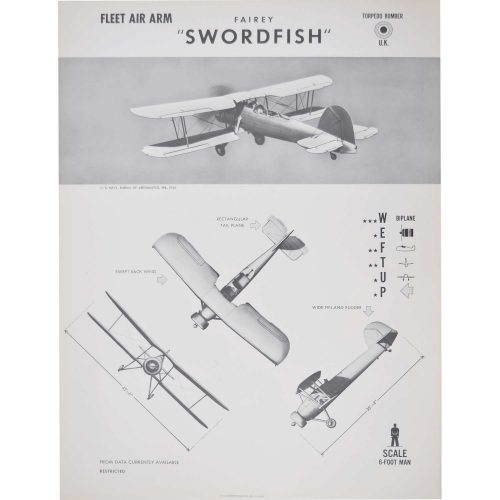
Fairey Swordfish
Aeroplane identification poster, published 1942 63 x 47 cm A particularly unusual style of aeroplane identification poster, owing to the very arty images. Most such posters rely on very plain silhouettes, this series - and we have several in this series; view them here - have a much more arty approach to the task with shading and an interesting angle view. The Fairey Swordfish is a biplane torpedo bomber designed by the Fairey Aviation Company. Originating in the early 1930s, the Swordfish, nicknamed "Stringbag", was operated by the Fleet Air Arm of the Royal Navy, it was also used by the Royal Air Force (RAF), as well as several overseas operators, including the Royal Canadian Air Force (RCAF) and the Royal Netherlands Navy. It was initially operated primarily as a fleet attack aircraft. During its later years, the Swordfish became increasingly used as an anti-submarine and training platform. The type was in frontline service throughout the Second World War. Despite being obsolete by 1939, the Swordfish achieved some spectacular successes during the war. Notable events included sinking one battleship and damaging two others of the Regia Marina (the Italian Navy) during the Battle of Taranto, and the famous attack on the Bismarck, which contributed to her eventual demise. By the end of the war, the Swordfish held the distinction of having caused the destruction of a greater tonnage of Axis shipping than any other Allied aircraft. The Swordfish remained in front-line service until V-E Day, having outlived multiple aircraft that had been intended to replace it in service. Condition: generally very good. If you are interested, please email info@manningfineart.co.uk or call us on 07929 749056. -
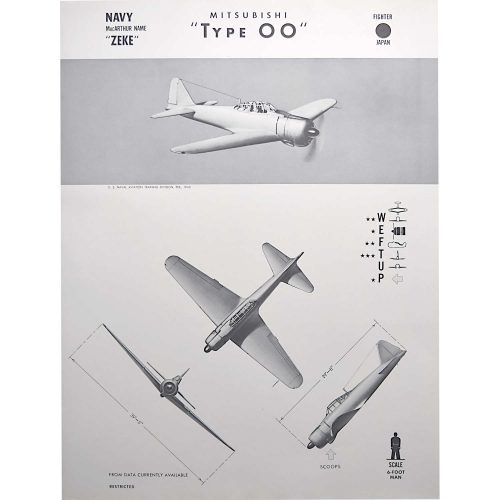
US Naval Aviation Training Division
MacArthur name "Zeke" or Zero Mitsubishi "Type 00" - Japanese fighter plane
Aeroplane identification poster, published 1943 63 x 47 cm A particularly unusual style of aeroplane identification poster, owing to the very arty images. Most such posters rely on very plain silhouettes, this series - and we have several in this series; view them here - have a much more arty approach to the task with shading and an interesting angle view. The Mitsubishi A6M "Zero" was a long-range carrier-based fighter aircraft formerly manufactured by Mitsubishi Aircraft Company, a part of Mitsubishi Heavy Industries, and was operated by the Imperial Japanese Navy from 1940 to 1945. The official Allied reporting name was "Zeke", although the name "Zero" (from Type 0) was used colloquially by the Allies as well. The Zero was considered to have been the most capable carrier-based fighter in the world when it was introduced early in World War II, combining excellent manoeuvrability and very long range. The Imperial Japanese Navy Air Service (IJNAS) also frequently used it as a land-based fighter. In early combat operations, the Zero gained a reputation as a dogfighter, achieving an outstanding kill ratio of 12 to 1, but by mid-1942 a combination of new tactics and the introduction of better equipment enabled Allied pilots to engage the Zero on generally equal terms. The Zero continued to serve in a front-line role until the end of the war in the Pacific; during the final phases, it was also adapted for use in kamikaze operations. Japan produced more Zeros than any other model of combat aircraft during the Second World War. Condition: generally very good. If you are interested, please email info@manningfineart.co.uk or call us on 07929 749056. -
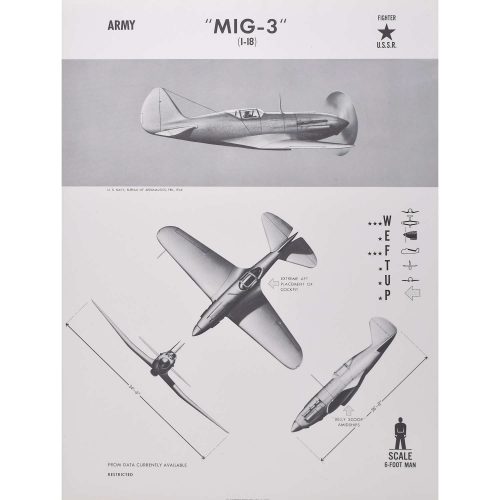
US Naval Aviation Training Division
MIG-3
Aeroplane identification poster, published 1942 63 x 47 cm A particularly unusual style of aeroplane identification poster, owing to the very arty images. Most such posters rely on very plain silhouettes, this series - and we have several in this series; view them here - have a much more arty approach to the task with shading and an interesting angle view. The Mikoyan-Gurevich MIG-3 was a Soviet fighter and interceptor aircraft used during World War II. It was a development of the MIG-1 by the Experimental Design Department of Factory No. 1 to remedy problems found during the MIG-1's development and operations. On 22 June 1941, at the beginning of Operation Barbarossa, some 981 MIG-3s were in service with the Soviet Air Forces, the Soviet Air Defence Forces, and Soviet Naval Aviation. The MIG-3 was difficult to fly in peacetime and much more so in combat. Originally designed as a high-altitude fighter-interceptor, combat over the Eastern Front was generally at lower altitudes, where it was inferior to the German Messerschmitt Bf 109 (a poster of which is available in our storefront) as well as most of its Soviet contemporaries. It was also pressed into service as a fighter-bomber during the autumn of 1941 but it was equally unsuited for this. The losses suffered in combat were very high, in percentage the highest among all the VVS fighters, with 1,432 shot down. Condition: generally very good. If you are interested, please email info@manningfineart.co.uk or call us on 07929 749056. -
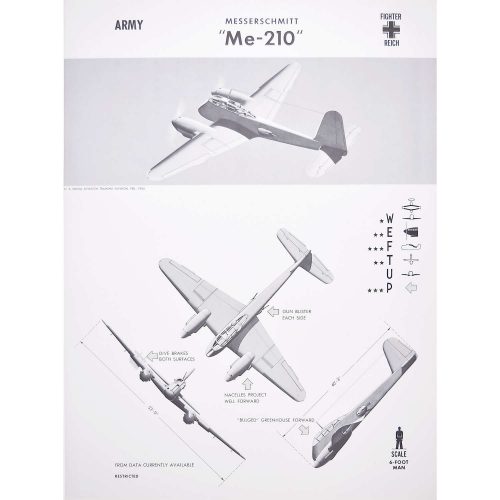
US Naval Aviation Training Division
Messerschmitt BF 210
Aeroplane identification poster, published 1942 63 x 47 cm A particularly unusual style of aeroplane identification poster, owing to the very arty images. Most such posters rely on very plain silhouettes, this series - and we have several in this series; view them here - have a much more arty approach to the task with shading and an interesting angle view. The Messerschmitt Me 210 was a two-seater German heavy fighter and ground-attack aircraft of World War II. Initial development of the 210 was started by Messerschmitt in 1938 at the request of the Luftwaffe. Condition: generally very good. If you are interested, please email info@manningfineart.co.uk or call us on 07929 749056. -
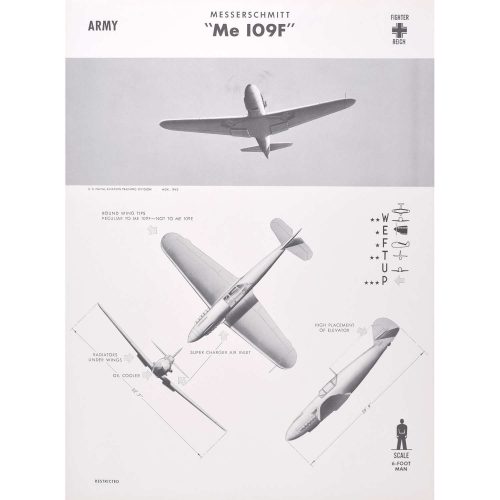
US Naval Aviation Training Division
Messerschmitt BF 109
Aeroplane identification poster, published 1942 63 x 47 cm A particularly unusual style of aeroplane identification poster, owing to the very arty images. Most such posters rely on very plain silhouettes, this series - and we have several in this series; view them here - have a much more arty approach to the task with shading and an interesting angle view. The Messerschmitt Bf 109 is a German World War II fighter aircraft that was, along with the Focke-Wulf Fw 190, the backbone of the Luftwaffe's fighter force. The Bf 109 first saw operational service in 1937 during the Spanish Civil War and was still in service at the dawn of the jet age at the end of World War II in 1945. It was one of the most advanced fighters when it first appeared, with an all-metal monocoque construction, a closed canopy, and retractable landing gear. It was powered by a liquid-cooled, inverted-V12 aero engine. It was called the Me 109 by Allied aircrew and some German aces, even though this was not the official German designation. It was designed by Willy Messerschmitt and Robert Lusser who worked at Bayerische Flugzeugwerke during the early to mid-1930s. It was conceived as an interceptor, although later models were developed to fulfil multiple tasks, serving as bomber escort, fighter-bomber, day-, night-, all-weather fighter, ground-attack aircraft, and reconnaissance aircraft. It was supplied to several states during World War II and served with several countries for many years after the war. The Bf 109 is the most produced fighter aircraft in history, with a total of 33,984 airframes produced from 1936 to April 1945. Some of the Bf 109 production took place in Nazi concentration camps through slave labor. The Bf 109 was flown by the three top-scoring fighter aces of all time, who claimed 928 victories among them while flying with Jagdgeschwader 52, mainly on the Eastern Front. The highest-scoring, Erich Hartmann, was credited with 352 victories. The aircraft was also flown by Hans-Joachim Marseille, the highest-scoring ace in the North African Campaign who shot down 158 enemy aircraft. It was also flown by many aces from other countries fighting with Germany, notably the Finn Ilmari Juutilainen, the highest-scoring non-German ace. Pilots from Italy, Romania, Croatia, Bulgaria, and Hungary also flew the Bf 109. Through constant development, the Bf 109 remained competitive with the latest Allied fighter aircraft until the end of the war. Condition: generally very good. If you are interested, please email info@manningfineart.co.uk or call us on 07929 749056. -
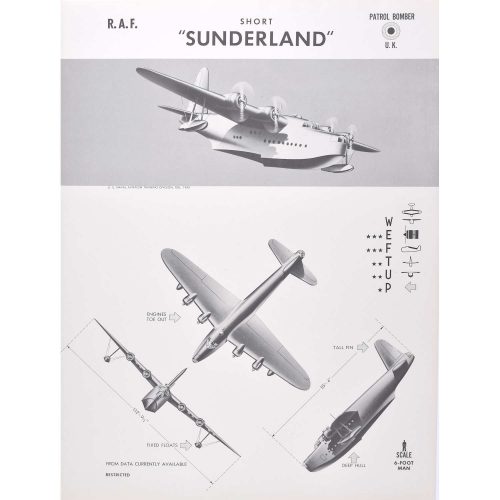
US Naval Aviation Training Division
Short Sunderland
Aeroplane identification poster, published 1942 63 x 47 cm A particularly unusual style of aeroplane identification poster, owing to the very arty images. Most such posters rely on very plain silhouettes, this series - and we have several in this series; view them here - have a much more arty approach to the task with shading and an interesting angle view. The Avro Lancaster is a British Second World War heavy bomber. It was designed and manufactured by Avro as a contemporary of the Handley Page Halifax, both bombers having been developed to the same specification, as well as the Short Stirling, all three aircraft being four-engined heavy bombers adopted by the Royal Air Force (RAF) during the same wartime era. The Short Sunderland was a British flying boat patrol bomber, developed and constructed by Short Brothers for the Royal Air Force (RAF). The aircraft took its service name from the town (latterly, city) and port of Sunderland in North East England. The Sunderland was one of the most powerful and widely used flying boats throughout the Second World War. In addition to the RAF, the type was operated by other Allied military air wings, including the Royal Australian Air Force (RAAF), Royal Canadian Air Force (RCAF), South African Air Force (SAAF), Royal New Zealand Air Force (RNZAF), French Navy, Norwegian Air Force, and the Portuguese Navy. During the conflict, the Sunderland was heavily involved in Allied efforts to counter the threat posed by German U-boats in the Battle of the Atlantic. On 17 July 1940, a RAAF Sunderland (of No. 10 Squadron) performed the type's first unassisted U-boat kill. The Sunderland also played a major role in the Mediterranean theatre, performing maritime reconnaissance flights and logistical support missions. During the evacuation of Crete, shortly after the German invasion of the island, several aircraft were used to transport troops. Numerous unarmed Sunderlands were also flown by civil operator British Overseas Airways Corporation (BOAC), traversing routes as far afield as the Pacific Ocean. Condition: generally very good, occasional handling marks. If you are interested, please email info@manningfineart.co.uk or call us on 07929 749056. -
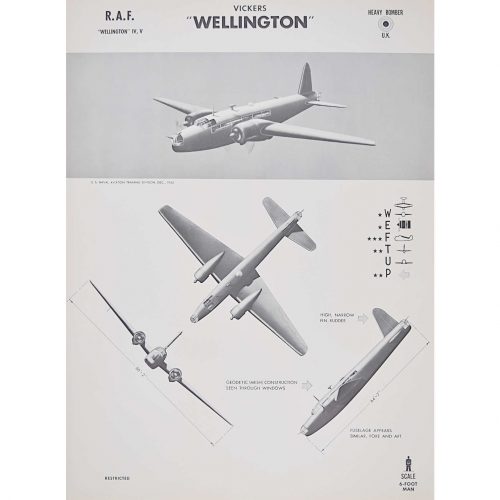
US Naval Aviation Training Division
Vickers Wellington
Aeroplane identification poster, 1942 63 x 47 cm A particularly unusual style of aeroplane identification poster, owing to the very arty images. Most such posters rely on very plain silhouettes, this series - and we have several in this series; view them here - have a much more arty approach to the task with shading and an interesting angle view. The Vickers Wellington was a British twin-engined, long-range medium bomber. It was designed during the mid-1930s at Brooklands in Weybridge, Surrey. Led by Vickers-Armstrongs' chief designer Rex Pierson; a key feature of the aircraft is its geodetic airframe fuselage structure, which was principally designed by Barnes Wallis. Development had been started in response to Air Ministry Specification B.9/32, issued in the middle of 1932, for a bomber for the Royal Air Force. This specification called for a twin-engined day bomber capable of delivering higher performance than any previous design. Other aircraft developed to the same specification include the Armstrong Whitworth Whitley and the Handley Page Hampden. During the development process, performance requirements such as for the tare weight changed substantially, and the engine used was not the one originally intended. The Wellington was used as a night bomber in the early years of the Second World War, performing as one of the principal bombers used by Bomber Command. During 1943, it started to be superseded as a bomber by the larger four-engined "heavies" such as the Avro Lancaster. The Wellington continued to serve throughout the war in other duties, particularly as an anti-submarine aircraft. It holds the distinction of having been the only British bomber that was produced for the duration of the war, and of having been produced in a greater quantity than any other British-built bomber. The Wellington remained as first-line equipment when the war ended, although it had been increasingly relegated to secondary roles. The Wellington was one of two bombers named after Arthur Wellesley, 1st Duke of Wellington, the other being the Vickers Wellesley. A larger heavy bomber aircraft designed to Specification B.1/35, the Vickers Warwick, was developed in parallel with the Wellington; the two aircraft shared around 85% of their structural components. Many elements of the Wellington were also re-used in a civil derivative, the Vickers VC.1 Viking. If you are interested, please email info@manningfineart.co.uk or call us on 07929 749056. -
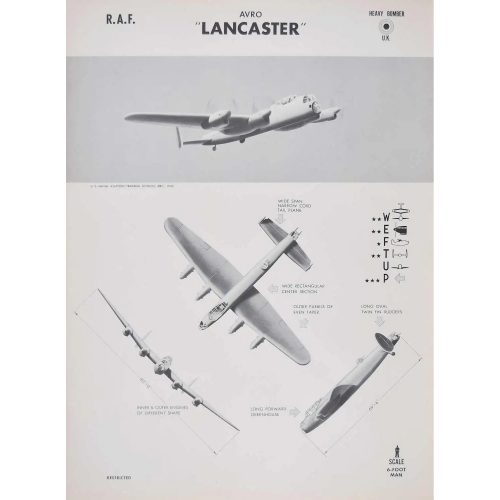
US Naval Aviation Training Division
Avro Lancaster
Aeroplane identification poster, published 1942 63 x 47 cm A particularly unusual style of aeroplane identification poster, owing to the very arty images. Most such posters rely on very plain silhouettes, this series - and we have several in this series; view them here - have a much more arty approach to the task with shading and an interesting angle view. The Avro Lancaster is a British Second World War heavy bomber. It was designed and manufactured by Avro as a contemporary of the Handley Page Halifax, both bombers having been developed to the same specification, as well as the Short Stirling, all three aircraft being four-engined heavy bombers adopted by the Royal Air Force (RAF) during the same wartime era. The Lancaster has its origins in the twin-engine Avro Manchester which had been developed during the late 1930s in response to the Air Ministry Specification P.13/36 for a capable medium bomber for "world-wide use". Originally developed as an evolution of the Manchester (which had proved troublesome in service and was retired in 1942), the Lancaster was designed by Roy Chadwick and powered by four Rolls-Royce Merlins and in one version, Bristol Hercules engines. It first saw service with RAF Bomber Command in 1942 and as the strategic bombing offensive over Europe gathered momentum, it was the main aircraft for the night-time bombing campaigns that followed. As increasing numbers of the type were produced, it became the principal heavy bomber used by the RAF, the Royal Canadian Air Force (RCAF) and squadrons from other Commonwealth and European countries serving within the RAF, overshadowing the Halifax and Stirling. A long, unobstructed bomb bay meant that the Lancaster could take the largest bombs used by the RAF, including the 4,000 lb (1,800 kg), 8,000 lb (3,600 kg) and 12,000 lb (5,400 kg) blockbusters, loads often supplemented with smaller bombs or incendiaries. The "Lanc", as it was known colloquially, became one of the most heavily used of the Second World War night bombers, "delivering 608,612 long tonnes of bombs in 156,000 sorties". The versatility of the Lancaster was such that it was chosen to equip 617 Squadron and was modified to carry the Upkeep "bouncing bomb" designed by Barnes Wallis for Operation Chastise, the attack on German Ruhr valley dams. Although the Lancaster was primarily a night bomber, it excelled in many other roles, including daylight precision bombing, for which some Lancasters were adapted to carry the 12,000 lb (5,400 kg) Tallboy and then the 22,000 lb (10,000 kg) Grand Slam earthquake bombs (also designed by Wallis). This was the largest payload of any bomber in the war. In 1943, a Lancaster was converted to become an engine test bed for the Metropolitan-Vickers F.2 turbojet. Lancasters were later used to test other engines, including the Armstrong Siddeley Mamba and Rolls-Royce Dart turboprops and the Avro Canada Orenda and STAL Dovern turbojets. Postwar, the Lancaster was supplanted as the main strategic bomber of the RAF by the Avro Lincoln, a larger version of the Lancaster. The Lancaster took on the role of long range anti-submarine patrol aircraft (later supplanted by the Avro Shackleton) and air-sea rescue. It was also used for photo-reconnaissance and aerial mapping, as a flying tanker for aerial refuelling and as the Avro Lancastrian, a long-range, high-speed, transatlantic passenger and postal delivery airliner. In March 1946, a Lancastrian of BSAA flew the first scheduled flight from the new London Heathrow Airport. Condition: generally very good, occasional handling marks. If you are interested, please email info@manningfineart.co.uk or call us on 07929 749056. -
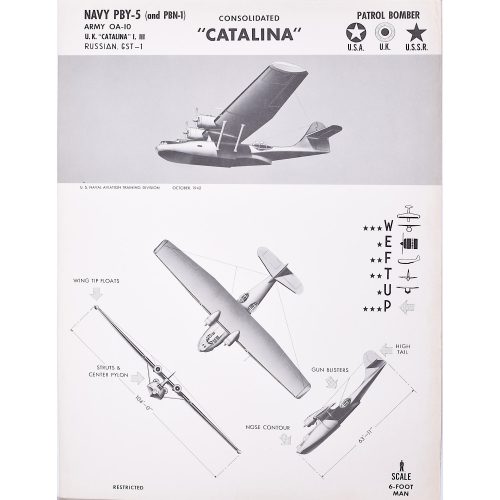
US Naval Aviation Training Division
Consolidated PBY Catalina World War 2 US airplane
Aeroplane identification poster, 1942 63 x 47 cm A particularly unusual style of aeroplane identification poster, owing to the very arty images. Most such posters rely on very plain silhouettes, this series - and we have several in this series (click here) - have a much more arty approach to the task with shading and an interesting angle view. The PBY Catalina is a flying boat used extensively during World War 2 in anti-submarine patrols, air-sea rescue, patrol bombing and convoy escort. It served militarily until the 1980s and was still being used in the 2010s as a waterbomber for firefighting. The RCAF called it the Canso. If you are interested, please email info@manningfineart.co.uk or call us on 07929 749056. -
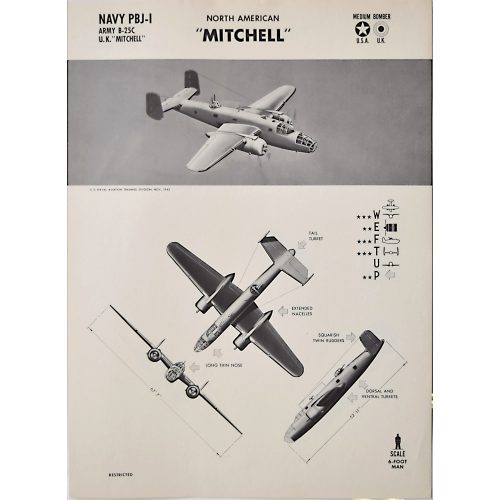
US Naval Aviation Training Division
B-25 Bomber North American Mitchell World War 2 US airplane
Original aeroplane identification poster, 1942 63 x 47 cm A particularly unusual style of aeroplane identification poster, owing to the very arty images. Most such posters rely on very plain silhouettes, this series - and we have several in this series - have a much more arty approach to the task with shading and an interesting angle view. Manufactured by North American Aviation and named in honour of Major General William 'Billy' Mitchell, a pioneer of US military aviation its first flight was in 1940 but it remained in service until 1979 (in the Indonesian air force). A particularly durable aircraft, one from the 321st Bomb Group was nicknamed 'Patches' on account of its (by the end of the war) 400 patched holes which had been painted with bright-yellow zinc chromate primer. Having completed over 300 missions and belly-landed six times the airframe was so distorted that 'straight-and-level' flight involved 8 degrees of left aileron trim and 6 degrees of right rudder causing the aircraft to 'crab' sideways through the air. Over one hundred B-25 Mitchells survive, with about 45 still airworthy. Seventeen flyable aircraft (and one hulk which was sacrificed to a crash scene) starred in the 1970 film 'Catch 22' fifteen of which still exist. If you are interested, please email info@manningfineart.co.uk or call us on 07929 749056. -
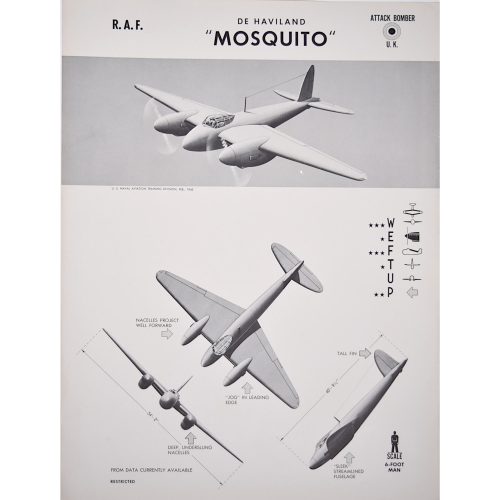
US Naval Aviation Training Division
DH Mosquito World War 2 US airplane
Original aeroplane identification poster, 1943 63 x 47 cm The Mosquito, the 'wooden wonder', was made entirely from wood to counteract metal shortages. Being wooden, it was very light, and when powered by two Merlin engines could outrun any German aeroplane, hence its use for Photographic Reconnaissance. Goering is reputed to have said: "In 1940 I could at least fly as far as Glasgow in most of my aircraft, but not now! It makes me furious when I see the Mosquito. I turn green and yellow with envy. The British, who can afford aluminium better than we can, knock together a beautiful wooden aircraft that every piano factory over there is building, and they give it a speed which they have now increased yet again. What do you make of that? There is nothing the British do not have. They have the geniuses and we have the nincompoops. When the war is over I shall buy a British radio set. Then at least I shall have something that works." If you are interested, please email info@manningfineart.co.uk or call us on 07929 749056. -
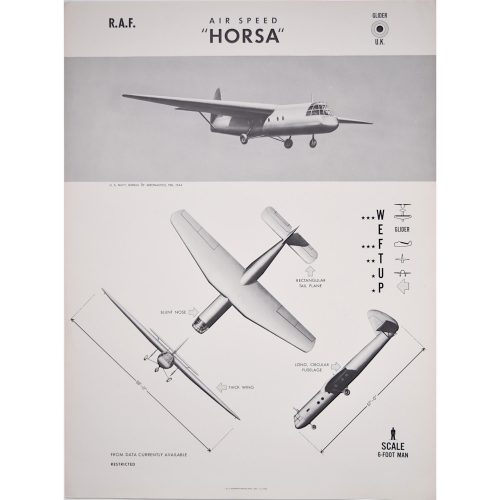
US Naval Aviation Training Division
Airspeed Horsa Glider World War 2 US airplane
Original aeroplane identification poster, 1943 63 x 47 cm In the days before helicopters it was gliders that allowed troops to be delivered to the ground. Essentially disposable aircraft (though obviously recovered where possible) they were light-weight and able to land in open fields where an aeroplane could not. Their ability to carry small tanks and other vehicles gave them a great advantage over simple paratroopers. Deployed to great effect in the D-Day Normandy landings and in the Market Garden advance, they were also widely used in Burma to supply the Chindits. One of the most terrifying methods of air transport during the War was the 'glider snatch'. A glider that had been used to deliver supplies or troops was reloaded with the wounded and then a passing aeroplane would pick up a rope attached to the front of the glider and snatch it into the air. The Horsa was a large glider, capable of accommodating 20-25 fully equipped paratroopers, and was first introduced in 1941. Made almost exclusively from wood - metal being in short supply - it was built by furniture factories. Between 3,799 and 5,000 Horsas were built - the varying numbers being down to the fact that many gliders were assembled at Maintenance Units rather than at the furniture factories (which lacked airfields). If you are interested, please email info@manningfineart.co.uk or call us on 07929 749056. -
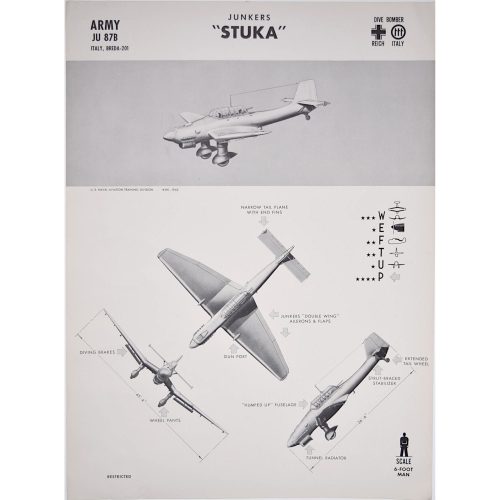
US Naval Aviation Training Division
Junkers Ju87 Stuka Dive Bomber - World War II aeroplane
Original aeroplane identification poster, 1943 63x47cm A particularly unusual style of aeroplane identification poster, owing to the very arty images. Most such posters rely on very plain silhouettes, this series - and we have several in this series (click here) - have a much more arty approach to the task with shading and an interesting angle view. Making its combat debut in 1937 with the Condor Legion during the Spanish Civil War it had a very distinctive silhouette as may be seen here. Essential to the rapid conquest of Norway, the Netherlands, Belgium and France in 1940 the Stuka was very effective against ground targets but vulnerable to fighter aircraft. It remained in service until the end of the War. If you are interested email info@manningfineart.co.uk or call us on 07929 749056. -
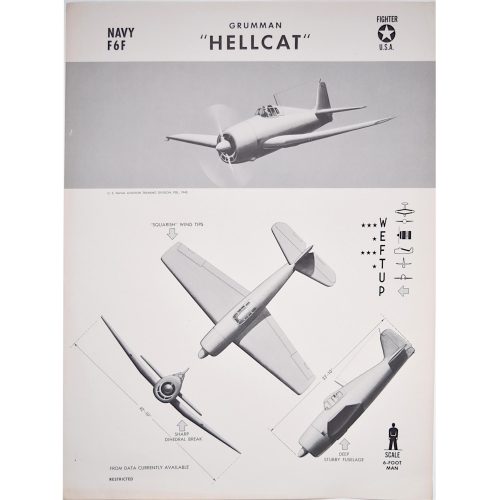
US Naval Aviation Training Division
Grumann F6F Hellcat World War 2 US airplane
Original aeroplane identification poster, 1943 63 x 47 cm The Grumman Hellcat was developed for the US Navy for the latter half of World War 2, becoming the dominant carrier-based aircraft being able to outperform the A6M Mitsubishi Zero. 12,275 were built in just over two years, being credited with 5,223 enemy kills - more than any other Allied naval aircraft. If you are interested, please email info@manningfineart.co.uk or call us on 07929 749056. -
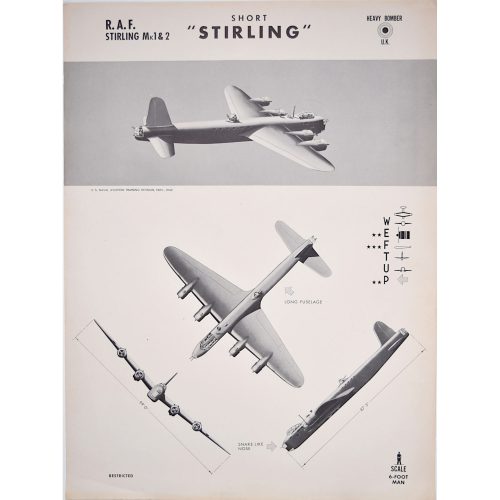
US Naval Aviation Training Division
Short Stirling World War 2 US airplane
Aeroplane identification poster, 1943 63 x 47 cm A particularly unusual style of aeroplane identification poster, owing to the very arty images. Most such posters rely on very plain silhouettes, this series - and we have several in this series (click here) - have a much more arty approach to the task with shading and an interesting angle view. Designed by Short Brothers, this was the RAF's first four-engined bomber entering service in 1941. Pilots liked its handling characteristics but the altitude ceiling was a matter of criticism and it was relegated to second-line duties in 1943 when the Halifax and Lancaster were available in sufficient numbers. It was subsequently used for mining harbours, as a glider tug and a supply aircraft. If you are interested, please email info@manningfineart.co.uk or call us on 07929 749056. -
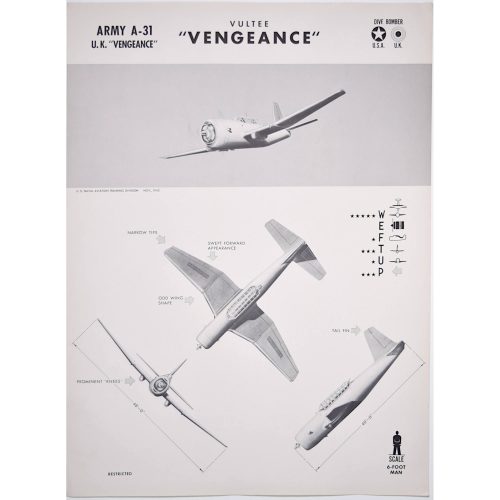
US Naval Aviation Training Division
1943 Vultee Vengeance World War 2 US airplane
Aeroplane identification poster, 1943 63 x 47 cm A particularly unusual style of aeroplane identification poster, owing to the very arty images. Most such posters rely on very plain silhouettes, this series - and we have several in this series (click here) - have a much more arty approach to the task with shading and an interesting angle view. Designed in 1940 as a single-engined dive bomber for the French Armée de l'Air, with deliveries scheduled for October 1940. With the fall of France in June 1940 the order was cancelled, but the British Royal Air Force ordered 200 of these dive bombers having been impressed by the Stuka. It was a reliable aircraft, stable in flight and in a dive. It was much used in Burma, this forgotten theatre of the war being regarded as a repository for otherwise unpopular and unwanted equipment, but where it proved very effective in bombing Japanese positions. If you are interested, please email info@manningfineart.co.uk or call us on 07929 749056. -

US Naval Aviation Training Division
Messerschmitt Bf 110 - World War II aeroplane
Aeroplane identification poster, 1943 63x47cm A particularly unusual style of aeroplane identification poster, owing to the very arty images. Most such posters rely on very plain silhouettes, this series - and we have several in this series (click here) - have a much more arty approach to the task with shading and an interesting angle view. A two-engined heavy fighter and fighter-bomber developed in German in the 1930s which saw service until the end of the war in 1945. It was a formidable radar-equipped night fighter with the top night-fighter ace Major Heinz-Wolfgang Schnaufer claiming 121 victories from 164 sorties. If you are interested email info@manningfineart.co.uk or call us on 07929 749056. -
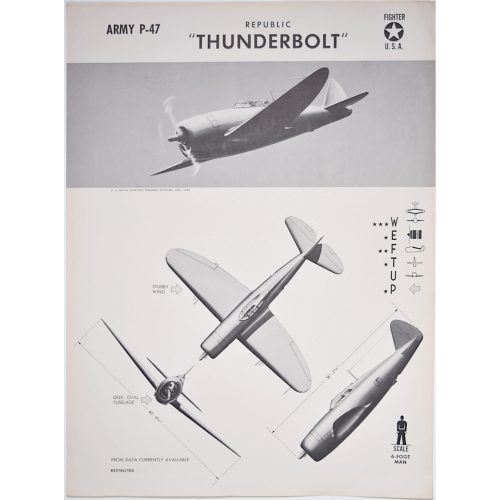
US Naval Aviation Training Division
Republic P47 Thunderbolt World War 2 US airplane
Aeroplane identification poster, 1943 63 x 47 cm A particularly unusual style of aeroplane identification poster, owing to the very arty images. Most such posters rely on very plain silhouettes, this series - and we have several in this series (click here) - have a much more arty approach to the task with shading and an interesting angle view. The Thunderbolt was produced between 1941 and 1945 as a fighter-bomber ground-attack airplane. POwered by a Pratt & Whitney R-2800 Double-Wasp engine it was successful both in European and Pacific theatres as one of the main USAAF fighters of the Second World War. Many remain airworthy, it being a popular 'warbird'. If you are interested, please email info@manningfineart.co.uk or call us on 07929 749056. -
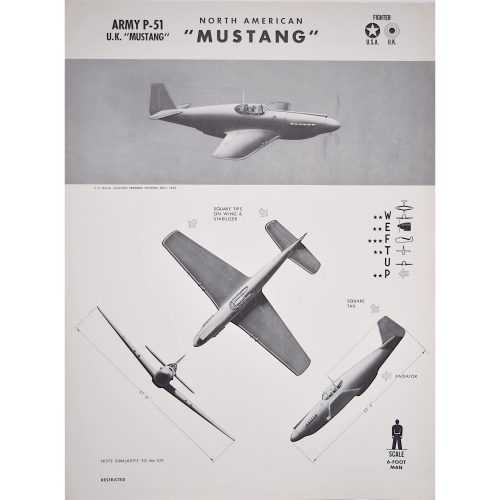
US Naval Aviation Training Division
North American Mustang P-51 World War 2 US airplane
Aeroplane identification poster, 1943 63x47cm A particularly unusual style of aeroplane identification poster, owing to the very arty images. Most such posters rely on very plain silhouettes, this series - and we have several in this series (click here) - have a much more arty approach to the task with shading and an interesting angle view. The Mustang is a long-range single-seat fighter/fighter-bomber that saw service during both the Second World War and Korean War. It was designed in 1940 by North American Aviation when they were commissioned to build Curtiss P-40 fighters under licence for the British Royal Air Force. Rather than build an old design, they designed this new aeroplane; the prototype was rolled out 102 days after the contract was signed. Powered by a Rolls-Royce Merlin engine over 15,000 were built with their most important role being escorting bombers over Germany. During World War II Mustang pilots accounted for a claimed 4,950 enemy aircraft. Today many survive and are a very popular 'warbird'. If you are interested email info@manningfineart.co.uk or call us on 07929 749056. -
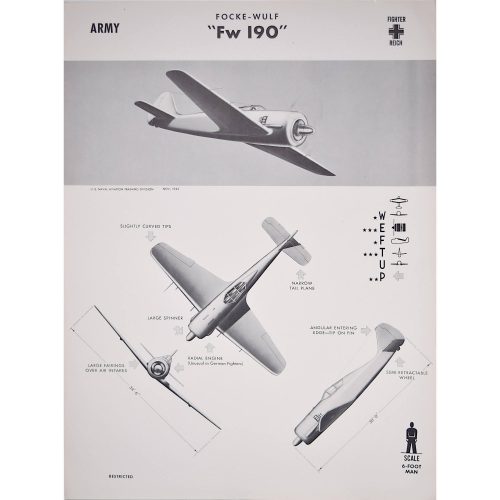
US Naval Aviation Training Division
Luftwaffe Focke-Wulf Fw190 - World War II aeroplane
Aeroplane identification poster, 1943 63 x 47cm A particularly unusual style of aeroplane identification poster, owing to the very arty images. Most such posters rely on very plain silhouettes, this series - and we have several in this series (click here) - have a much more arty approach to the task with shading and an interesting angle view. The Würger (in English, Shrike) is a single-seat single-engined fighter airplane widely used during World War II by the Germans. Designed in 1936 over 20,000 were built, beginning operations in August 1941 outclassing the Spitfire Mk V - remaining so until the Spitfire Mk IX was introduced. Both the French Air Force and French Navy purchased and operated the Fw 190 following the end of the war. Today some 28 examples survive, plus 20 modern reproductions. If you are interested, please email info@manningfineart.co.uk or call us on 07929 749056. -

US Naval Aviation Training Division
Luftwaffe Dornier Do 217 Medium/Heavy Bomber
Aeroplane identification poster, 1943 63x47cm A particularly unusual style of aeroplane identification poster, owing to the very arty images. Most such posters rely on very plain silhouettes, this series - and we have several in this series (click here) - have a much more arty approach to the task with shading and an interesting angle view. A two-engined heavy bomber developed in German in the late 1930s for short-range bombing and as a more powerful development of the Do 17 - the flying pencil. It saw service until the end of the war in 1945. A versatile aircraft it was used as a night fighter, torpedo bomber, strategic bomber and reconnaissance aircraft. No complete example survives to this day despite a production of 1,925. If you are interested email info@manningfineart.co.uk or call us on 07929 749056. -
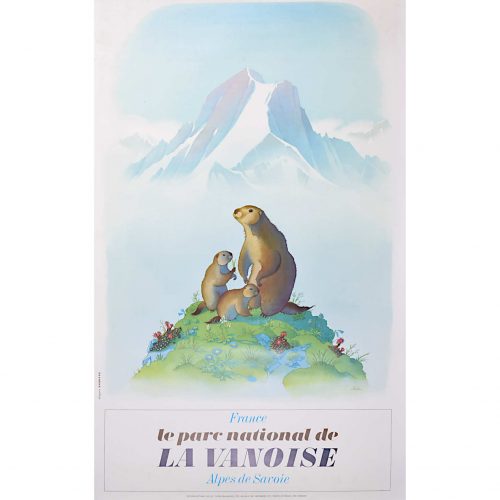
'Samivel' Paul Gayet-Tancrède (1907-1992)
Le Parc National de la Vanoise, Alpes de Savoie
Editions Mythra SA Chamonix Original Vintage Ski Poster 99x62cm Condition: Excellent, with four small glue marks to reverse not affecting image. With the ever-popular topic of skiing, Samivel here catches a Marmot atop a Vanoise hill, a mountain peak in the background. The Marmot, a squirrel-like rodent, is always a sign of the impending end of the ski season as it comes out with the warmer weather as spring approaches. Click here to see other posters by Samivel. Samivel was a writer, an artist, a photographer, an explorer and more. In 1948 he accompanied Paul Émile Victor on the first French Greenland expedition, making three documentary films in the process. His friends included Théodore Monod and Gilbert André - the latter the mayor of Bonneval-sur-Arc and one of the founders of the Vanoise National Park - and with them and others he spent his whole life aiming for the protection of the imperilled countryside. The graphic artist side of him had a life-long fascination with high mountains, and his illustrated books and series of posters of the French Alps have long been popular. If you are interested email info@manningfineart.co.uk or call us on 07929 749056. -
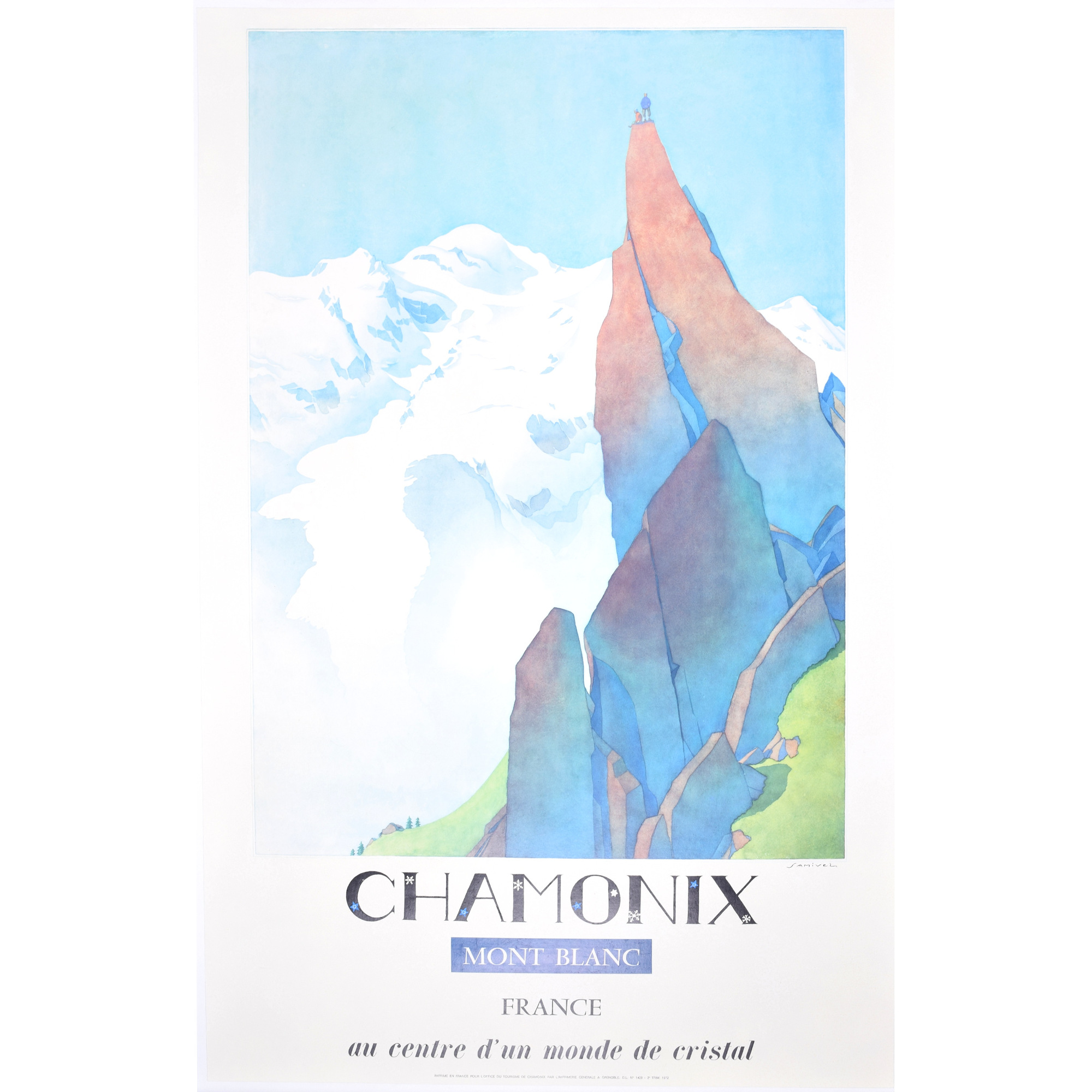
'Samivel' Paul Gayet-Tancrède (1907-1992)
Chamonix Mont Blanc, France - au centre d'un monde de cristal
Imprimé en France pour l'office du tourisme de Chamonix par l'imprimerie generale a Grenoble Original Vintage Ski Poster 99x62cm Condition: excellent With the ever-popular topic of mountains for climbing and skiing, Samivel here draws one of the Aiguille or Aiguillettes - needles - in Chamonix which are famous for climbers. Samivel was a writer, an artist, a photographer, an explorer and more. In 1948 he accompanied Paul Émile Victor on the first French Greenland expedition, making three documentary films in the process. His friends included Théodore Monod and Gilbert André - the latter the mayor of Bonneval-sur-Arc and one of the founders of the Vanoise National Park - and with them and others he spent his whole life aiming for the protection of the imperilled countryside. The graphic artist side of him had a life-long fascination with high mountains, and his illustrated books and series of posters of the French Alps have long been popular. Click here to see other posters by Samivel. If you are interested email info@manningfineart.co.uk or call us on 07929 749056. -

'Samivel' Paul Gayet-Tancrède (1907-1992)
Du Léman à La Méditerranée, La Grande Traversée des Alpes Françaises
('From Lake Geneva to the Mediterranean, La Grande Traversée of the French Alps') Imprimé en France - Printed in France 1975 Original Vintage Ski Poster 99x62cm Condition: excellent With the ever-popular topic of mountains for climbing and skiing, Samivel here draws a snow-covered col in the mountains. La Grande Traversée is a long-distance walking route from Thonon les Bains to Nice, set up in the early 1970s. Samivel was a writer, an artist, a photographer, an explorer and more. In 1948 he accompanied Paul Émile Victor on the first French Greenland expedition, making three documentary films in the process. His friends included Théodore Monod and Gilbert André - the latter the mayor of Bonneval-sur-Arc and one of the founders of the Vanoise National Park - and with them and others he spent his whole life aiming for the protection of the imperilled countryside. The graphic artist side of him had a life-long fascination with high mountains, and his illustrated books and series of posters of the French Alps have long been popular. Click here to see other posters by Samivel. If you are interested email info@manningfineart.co.uk or call us on 07929 749056. -
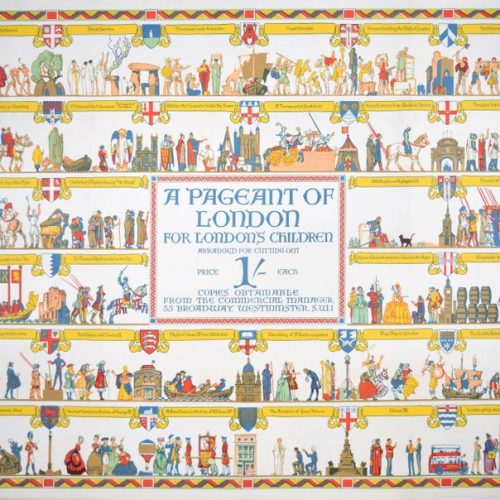
Elijah Albert Cox (1876–1955)
Pageant of London (1926)
Original London Transport Underground posterLithograph102 x 127 cmThis fantastic poster illustrates London-related events from British history, and advertises a cutting-out book designed for children.Cox was born in Islington and studied at Whitechapel People's Palace and then the London College of Printing. Having worked as an assistant to Frank Brangwyn, and as a designer for a manufacturing chemist, he became a mural and poster designer. Elected to the Royal Society of British Artists in 1915, commissions came from London Underground, the Empire Marketing Board and others. He also illustrated books - mostly historical and heroic adventures.If you are interested, please email info@manningfineart.co.uk or call us on 07929 749056. -
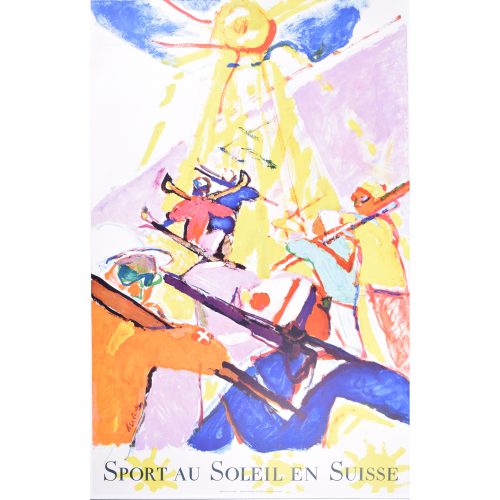
Hans Falk (1918-2002)
Sport au Soleil en Suisse
Original Vintage Poster (1957) Lithograph 40x25" Signed in the plate, and showing a procession of brightly-coloured skiers heading up the mountain towards the sun. Falk was a Swiss graphic designer who spent much of his life in the USA, UK and Ireland, producing many striking and popular posters. -
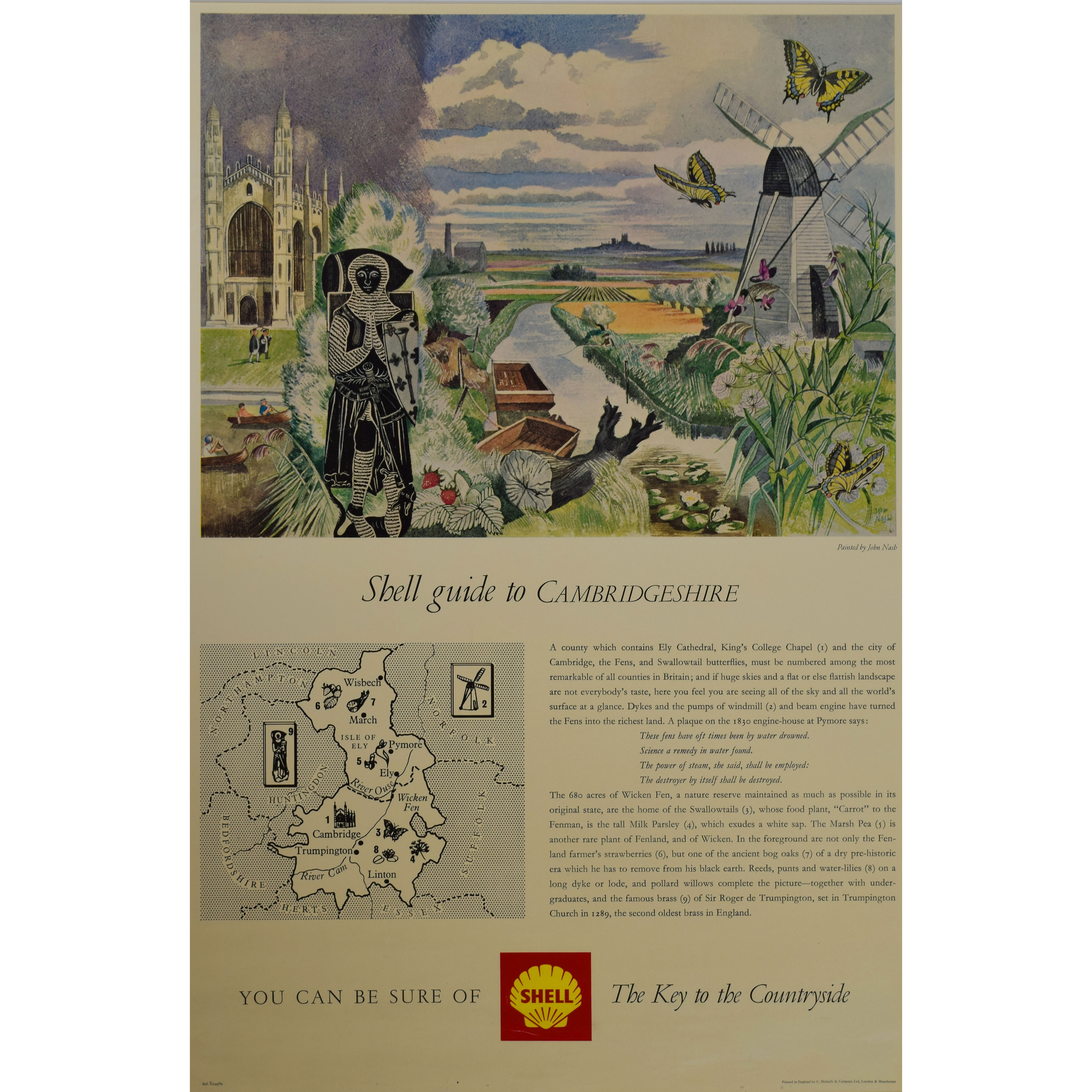
John Nash
Shell Guide to Cambridgeshire Original poster c. 1960s 76x51cm Shell commissioned a series of posters to go with their County Guide books, and they commissioned paintings by the leading artists of the day. Nash needs no introduction as an artist. A painter of landscapes and still-lives and illustrator - particularly of botanic works - who worked extensively with wood engravings, he was a natural choice for Shell. His most famous work is probably 'Over the Top' which hangs in the Imperial War Museum, relating to a counter-attack by 1st Battalion Artists' Rifles at Welsh Ridge on 30 December 1917. Of the eighty men who went over the top, sixty-eight were killed or wounded within the first few minutes. Nash escaped and painted the picture three months later. The Tate holds his 1918 painting 'The Cornfield' which was his first non-war painting (he only started painting in oils in 1914). Condition: mounted in conservation mount and wrapped in plastic sleeve (mount hides short edge tears). -
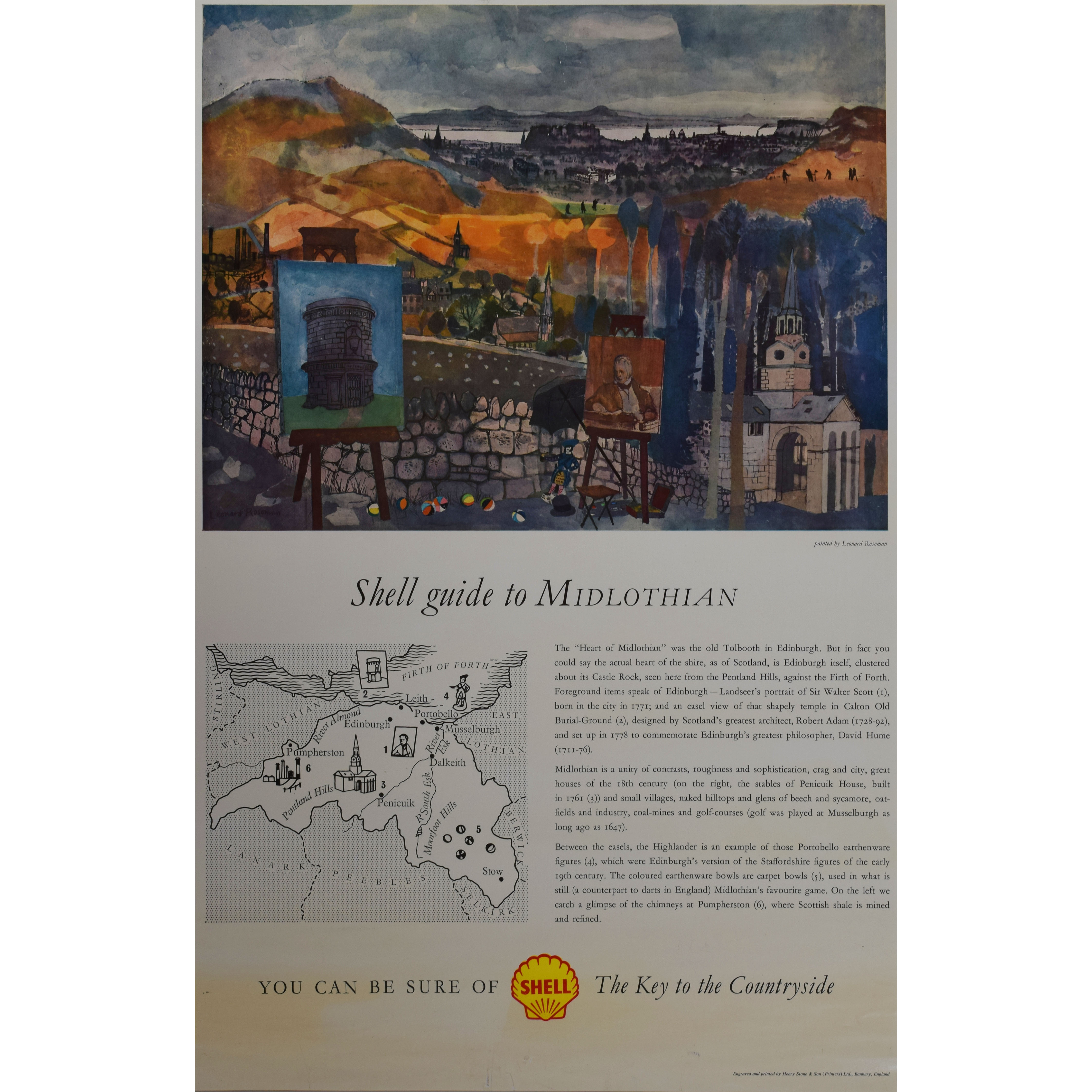
Leonard Rosoman
Shell Guide to Midlothian Original poster c. 1960s 76x51cm Shell commissioned a series of posters to go with their County Guide books, and they commissioned paintings by the leading artists of the day. Born in London, Rosoman studied at the Royal Academy Schools and then the Central School. His first major commission was to illustrate the popular children's book 'My Friend Mr Leakey' in 1937. Joining the Auxiliary Fire Service during World War II, he painted many scenes from the Blitz, some of which are in the Imperial War Museum collection. Seconded to the War Office in 1943 to illustrate books on fire-fighting the War Artists' Advisory Committee gave him a full-time post with the British Pacific Fleet, sailing with HMS Formidable the aircraft carrier. After the war he taught at Camberwell College of Art. He painted a mural for the Festival of Britain in 1951, murals for the British Pavilion at the 1958 Brussels International Exhibition, and for the restaurant at the Royal Academy's Burlington House - becoming RA in 1969. Condition: mounted in conservation mount and wrapped in plastic sleeve (mount hides short edge tears). -
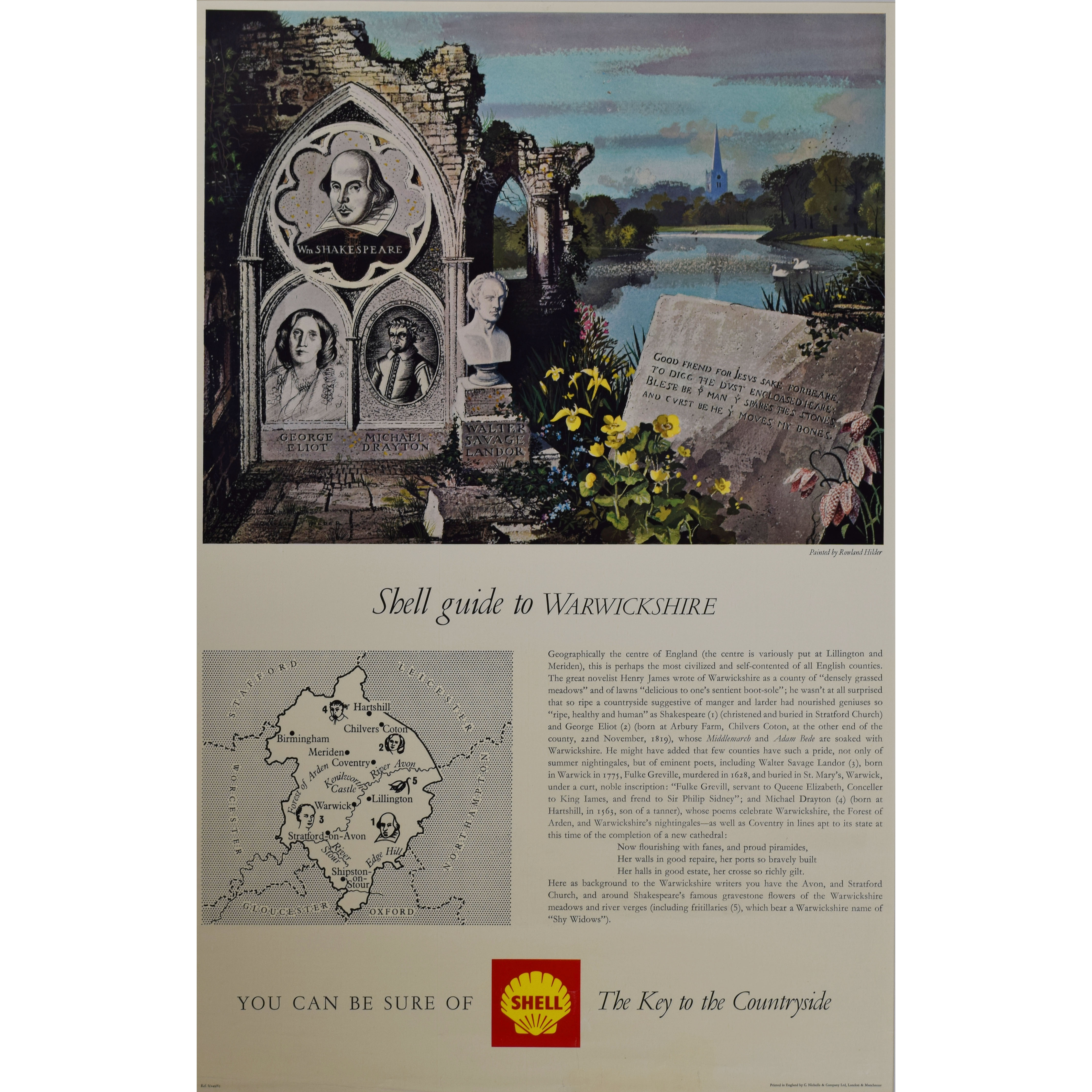
Rowland Hilder
Shell Guide to Warwickshire Original poster c. 1960s 76x51cm Shell commissioned a series of posters to go with their County Guide books, and they commissioned paintings by the leading artists of the day. Rowland Hilder was a well known landscape artist and book illustrator. Born in New York state, his English father moved the family to Kent, England in 1915. It was here his natural talent for drawing was noticed by his school. Later Hilder went to study at Goldsmith’s College in London. He was well known as an accomplished watercolorist, particularly in his sensitive handling of the sky and earth. Between 1964 and 1974 he was president of England’s Royal Institute of Painters in Watercolours. Condition: mounted in conservation mount and wrapped in plastic sleeve (mount hides short edge tears). -
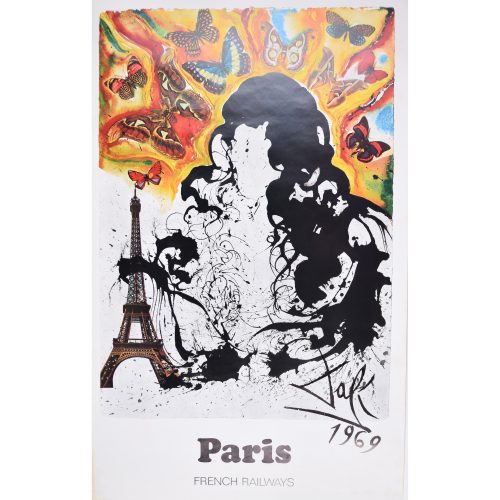
Salvador Dali (1904-1989) Paris, France - French Railways
Lithographic poster 101 x 63.5 cm For French Railways SNCF Printed by Draeger Printed in France for and by the French National Railways, 1970 Signed and dated in the stone 1969 Generally very good; occasional slight browning to the very edges -
Out of stock
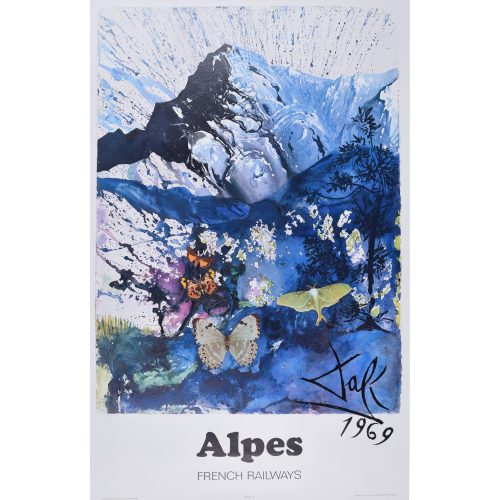
Salvador Dali (1904-1989) Alpes French Railways - The Alps
Original Poster for French Railways SNCF 40x25" (100x67cm) Printed by Draeger Printed in France for and by the French National Railways, 1970 Signed and dated in the stone 1969 Printed on wove - a thicker paper than the standard poster which is also textured. Condition: very good -

Salvador Dali (1904-1989) Alpes French Railways - The Alps
Original Poster for French Railways SNCF 40x25" (100x67cm) Printed by Draeger Printed in France for and by the French National Railways, 1970 Signed and dated in the stone 1969 Condition: very good, slight age toning/handling wear to very edges as usual -
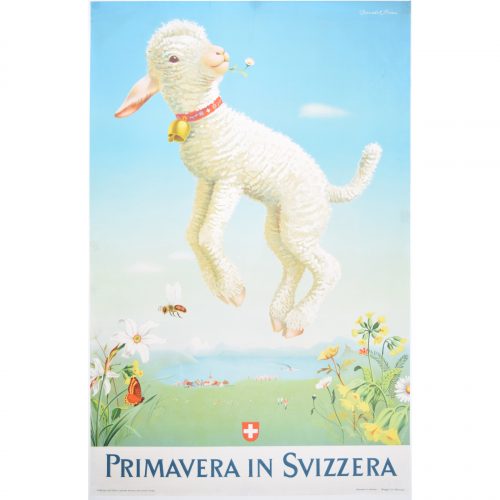
Donald Brun (1909-1999)
Primavera in Svizzera (1945) Lithographic poster Printed by Swiss National Tourist Office, Zurich 40×25 inches This poster won a Swiss Poster award in 1945 Donald Brun produced his famous series of posters for Switzerland as global travel became more possible. Here a Swiss steamer boat is seen crossing Lake Geneva (presumably) as a lamb celebrates spring, cavorting with a bee and a butterfly. -

What to Eat and Why
Original Poster 51x76cm If you are interested email info@manningfineart.co.uk or call us on 07929 749056. -
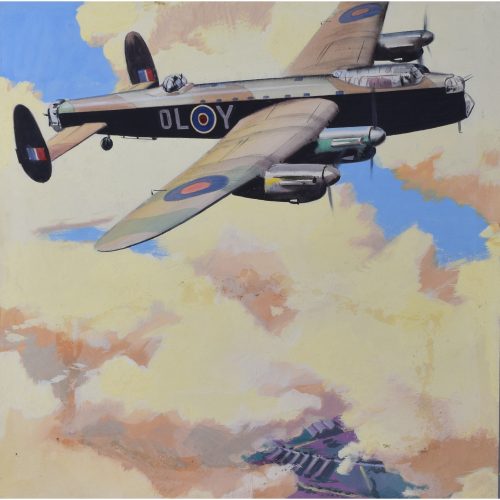
Ernest Bendell-Bayly Lancaster Bomber
Oil on paper laid on board 39x38cm Design for a poster 1940s If you are interested email info@manningfineart.co.uk or call us on 07929 749056. Ernest Bendell-Bayly was a partner in the Bayly-Souster advertising agency, employer of, amongst others, Owen Miller. They produced many posters for the Ministry of Aircraft Production during the war. -
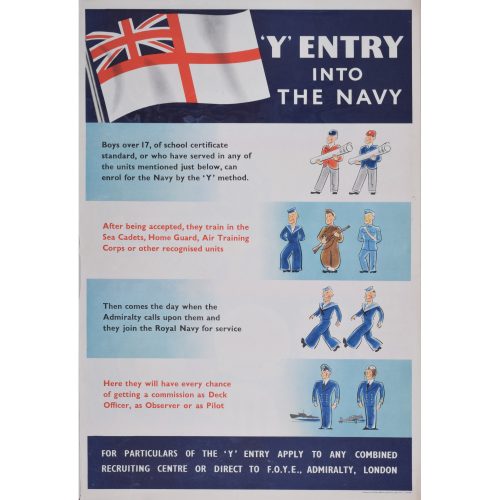
Y Entry to the Navy
Original Lithographic Poster 76x51cm If you are interested, email info@manningfineart.co.uk or call us on 07929 749056. -
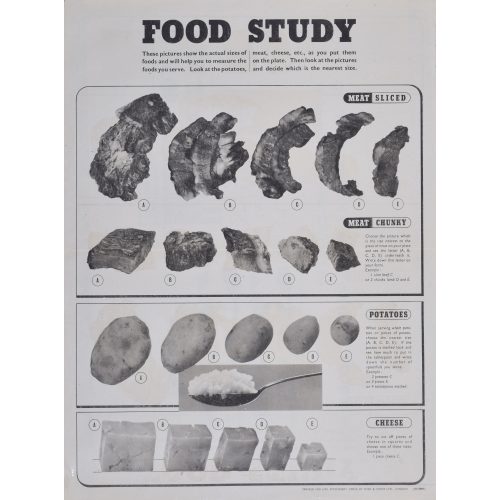
Food Study
Original Poster 51x76cm If you are interested email info@manningfineart.co.uk or call us on 07929 749056. -
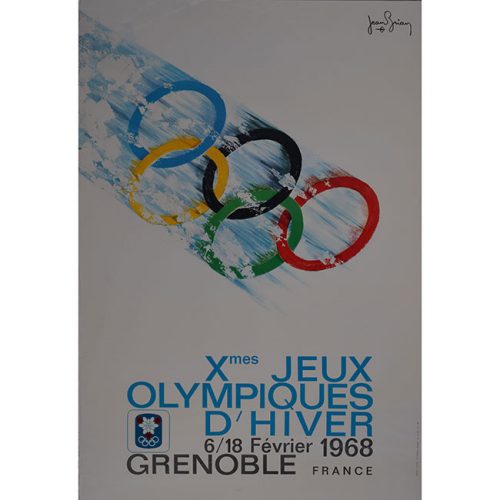
Jean Brian (1910-90)
X Jeux Olympiques d'Hiver (1968 Winter Olympics Grenoble France)
1968 Lithographic poster 95.1x 63.4cm If you are interested email info@manningfineart.co.uk or call us on 07929 749056. -
Out of stock
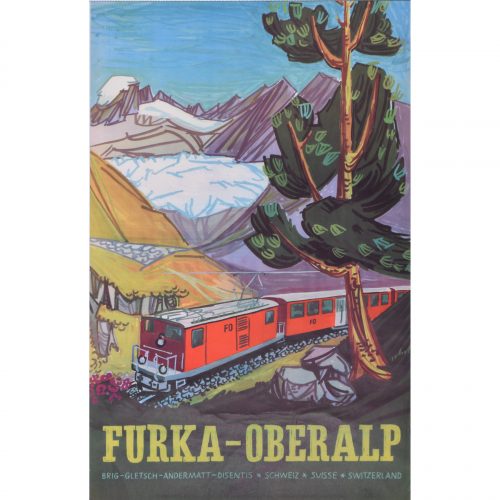
Hugo Schol (Swiss, 20th Century)
Furka Oberalp
Lithographic poster (1959) Brig-Gletsch-Andermatt-Disentis *Schweiz*Suisse*Switzerland 20x12.5" An arresting scene of the Furka Oberalp Bahn/Railway by one of the best Swiss poster artists of the period. Here in a conveniently small size, the red of the train contrasts with the vivid colours of the Alps. -
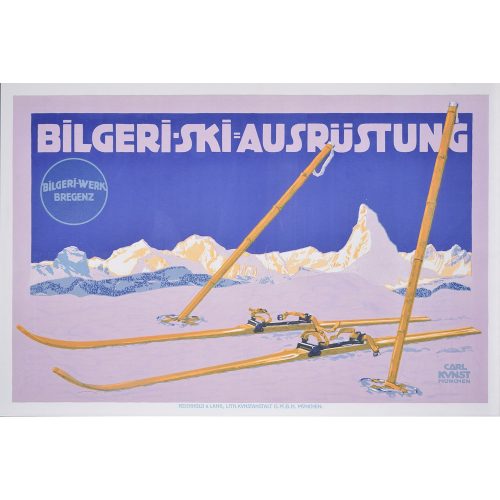
Carl Kunst (1884-1912) Bilgeri Ski Ausrüstung
51x85cm Lithographic poster Reichhold & Lang, Lith. Kunstanstalt GMBH München A view of the Matterhorn - the obvious mountain in the background - near Zermatt in Switzerland, made for Bilgeri Week in Bregenz with old-fashioned wooden skis and poles c. 1910. Bilgeri were an Austrian manufacturer of skis. If you are interested email info@manningfineart.co.uk or call us on 07929 749056. -

'Zero' Hans Schleger (1898-1976) Grow Your Own Food
Lithographic poster c. 1940 Printed by Fosh & Kosh Limited for HMSO 76x51cm A copy of this poster is in the collection of the Imperial War Museum. Click here for biographical details and other posters by Hans 'Zero' Schleger. Provenance: the estate of the artist. If you are interested email info@manningfineart.co.uk or call us on 07929 749056. -
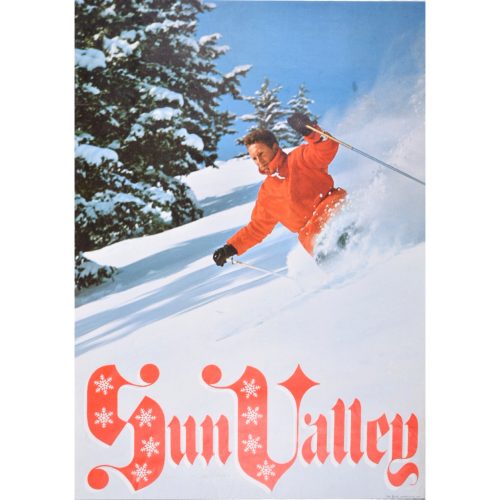
Sun Valley
Original lithographic poster c. 1965 76x51cm Published by LooArt Press, Colorado The resort was the first destination winter resort in the US and was developed by W A Harriman, the chairman of the Union Pacific Railroad to increase passenger numbers. The Austrian Count Schaffgotsch was instructed to find a suitable site and Sun Valley was born. Sun Valley was the site of the world's first chairlifts as single-seat chairs were installed in 1936 for the opening. The poster is believed to depict Sigfried 'Sigi' Engl, an Austrian who became director of Sun Valley Ski School in 1952 and made it famous for his innovative instructional methods. A few light creases and small spot towards top right. -
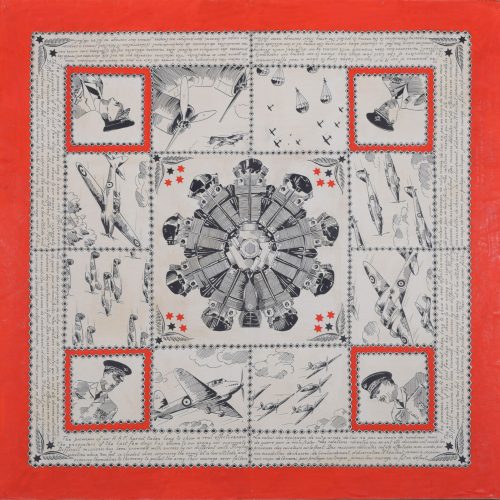
Design for Bianchini Ferier, Lyon for a scarf
Pen and Gouache c. 1940 75cm x 75cm "The prowess of our R.A.F. has not taken long to show a real effectiveness. The encounters of the last few days has sown to our enemy our supremacy. Difficult missions have been crowned with success by our different units. Flying sometime above 7000 feet in clouded skies surprising the enemy at a low altitude and exposing themselves to the enemy to protect the army. Their courage never falters." In the months prior to the Fall of France in May 1940 - before the Battle of Britain began - the RAF was in action in the skies above France and this design for a scarf depicts aeroplanes and pilots of the RAF. -
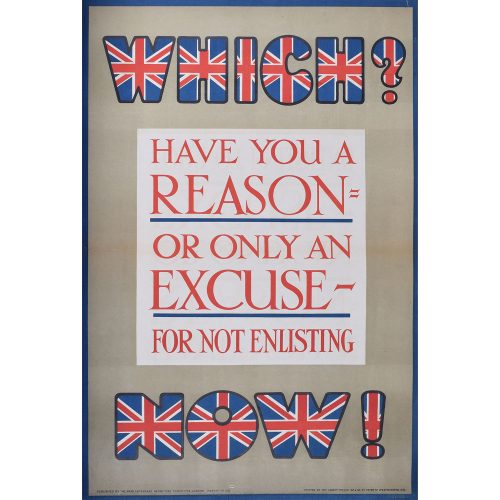
Parliamentary Recruiting Committee Which? Have you a Reason for not Enlisting - Or only an Excuse for not Enlisting. Now!
Original lithographic poster c. 1914 75 x 50cm Published by the Parliamentary Recruiting Committee, London Printed by the Abbey Press 32 & 34 Great Peter St Westminster SW Before conscription was introduced at the beginning of 1916, recruitment into the British Army was all by way of volunteering. Lord Kitchener, Secretary of State for War, wanted to recruit almost 100,000 men per month and by the end of 1915 the supply of volunteers - despite excellent posters such as this one - was drying up.

